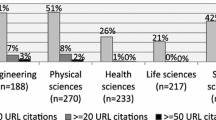Abstract
An investigation of links to 89 US academic departments from three different disciplines gave insights into the kinds of international regions and national domains that linked to them. While significant correlations were found between total counts of international inlinks and total publication impact in Psychology and Chemistry, counts of international inlinks to History departments were too small to give a significant result. The correlations suggest that international links may reflect, to a certain extent, patterns of scholarly communication. Even though History departments attracted a significantly lower percentage of international inlinks than those of Chemistry and Psychology, the main source of links for all three disciplines was from Europe. Analyses of national inlinks, characterized by gTLDs (generic Top Level Domains), showed that the major source of links for all disciplines was .edu sites, followed by .com, .org, .net. As a whole, international regional differences in disciplines were stronger than gTLD differences, although in both cases discrepancies were not of a large scale.
Similar content being viewed by others
References
Aguillo, I. F. (1998), STM information on the Web and the development of new Internet R&D databases and indicators. In: Online Information 98: Proceedings. Learned Information, pp. 239-243.
Almind, T. C., Ingwersen, P. (1997), Informetric analyses on the world wide Web: methodological approaches to ‘Webometrics’. Journal of Documentation, 53(4): 404-426.
Bar-Ilan, J. (2001), Data collection methods on the web for informetric purposes — A review and analysis, Scientometrics, 50(1): 7-32.
BjÖrneborn, L., Ingwersen, P. (2001), Perspectives of webometrics, Scientometrics, 50(1): 65-82.
Borgman, C., Furner, J. (2002), Scholarly communication and bibliometrics. In: Cronin, B. (Ed.), Annual Review of Information Science and Technology, Medford, NJ: Information Today Inc, 36: 3-72.
Cronin, B. (2001), Bibliometrics and beyond: Some thoughts on web-based citation analysis. Journal of Information Science, 27(1): 1-7.
Furner, J., Ellis, D., Willett, P. (1999), Inter-linker consistency in the manual construction of hypertext documents, ACM Computing Surveys (CSUR), 31(4es) [On-line supplement].
GlÄnzel, W., Schubert, A. (2001), Double effort = Double impact? A critical view at international co-authorship in chemistry, Scientometrics, 50(2): 199-214.
IANA (2003), Generic Top-Level Domains. Retrieved 8 January, 2003 from http://www.iana.org/gtld/gtld.htm
Ingwersen, P. (1998), The calculation of Web Impact Factors. Journal of Documentation, 54(2): 236-243.
Kling, R., McKim, G. (2000), Not just a matter of time: field differences in the shaping of electronic media in supporting scientific communication. Journal of the American Society for Information Science, 51(14): 1306-1320.
Lange, L. (1985), Effects of disciplines and countries on citation habits. Scientometrics, 8(3–4): 205-215.
Li, X., Thelwall, M., Musgrove, P., Wilkinson, D. (2003), The relationship between the links/Web Impact Factors of computer science departments in UK and their RAE (Research Assessment Exercise) ranking in 2001. Scientometrics, 57(2): 239-255.
clustering&mapping.pdf
Rousseau, R. (1997), Sitations: an exploratory study, Cybermetrics, 1. Available: http://www.cindoc.csic.es/cybermetrics/articles/v1i1p1.html
Rousseau, R. (1999), Daily time series of common single word searches in AltaVista and NorthernLight, Cybermetrics, 2/3. Available: http://www.cindoc.csic.es/cybermetrics/articles/v2i1p2.html
Smith, A. G. (1999), A tale of two web spaces: comparing sites using Web Impact Factors, Journal of Documentation, 55(5): 577-592.
Smith, A., Thelwall, M. (2002),Web Impact Factors for Australasian universities, Scientometrics, 54(3): 363-380.
Snyder, H., Rosenbaum, H. (1999), Can search engines be used for web-link analysis? A critical review. Journal of Documentation, 55(4): 375-384.
Tang, R., Thelwall, M. (2003), US academic departmental Web-site interlinking: Disciplinary differences. Library & Information Science Research, 25: 437-458.
Thelwall, M. (2002a), Conceptualizing documentation on the web: an evaluation of different heuristic-based models for counting links between university web sites, Journal of the American Society for Information Science and Technology, 53(12): 995-1005.
Thelwall, M. (2002b), Evidence for the existence of geographic trends in university web site interlinking, Journal of Documentation, 58(5): 563-574.
Thelwall, M. (2004), Methods for reporting on the targets of links from national systems of university Web sites, Information Processing & Management, 40(1): 125-144.
Thelwall, M., Smith, A. (2002), A study of the interlinking between Asia-Pacific university Web sites, Scientometrics, 55(3): 363-376.
Thelwall, M., Tang, R., Price, E. (2003), Linguistic patterns of academic Web use in Western Europe, Scientometrics, 56(3): 417-432.
Thelwall, M., Tang, R. (2003), Disciplinary and linguistic considerations for academic Web linking: An exploratory hyperlink mediated study with Mainland China and Taiwan, Scientometrics, 58(1): 153-179.
Thomas, O., Willett, P. (2000), Webometric analysis of departments of Librarianship and information science. Journal of Information Science, 26(6): 421-428.
Vaughan, L., Thelwall, M. (2003), Scholarly use of the web: What are the key inducers of links to journal web sites? Journal of the American Society for Information Science and Technology, 54(1): 29-38.
Wilkinson, D., Harries, G., Thelwall, M., Price, E. (2003), Motivations for academic Web site interlinking: Evidence for the web as a novel source of information on informal scholarly communication, Journal of Information Science, 29(1): 59-66.
Author information
Authors and Affiliations
Rights and permissions
About this article
Cite this article
Tang, R., Thelwall, M. Patterns of national and international Web inlinks to US academic departments: An analysis of disciplinary variations. Scientometrics 60, 475–485 (2004). https://doi.org/10.1023/B:SCIE.0000034388.70594.cc
Issue Date:
DOI: https://doi.org/10.1023/B:SCIE.0000034388.70594.cc




